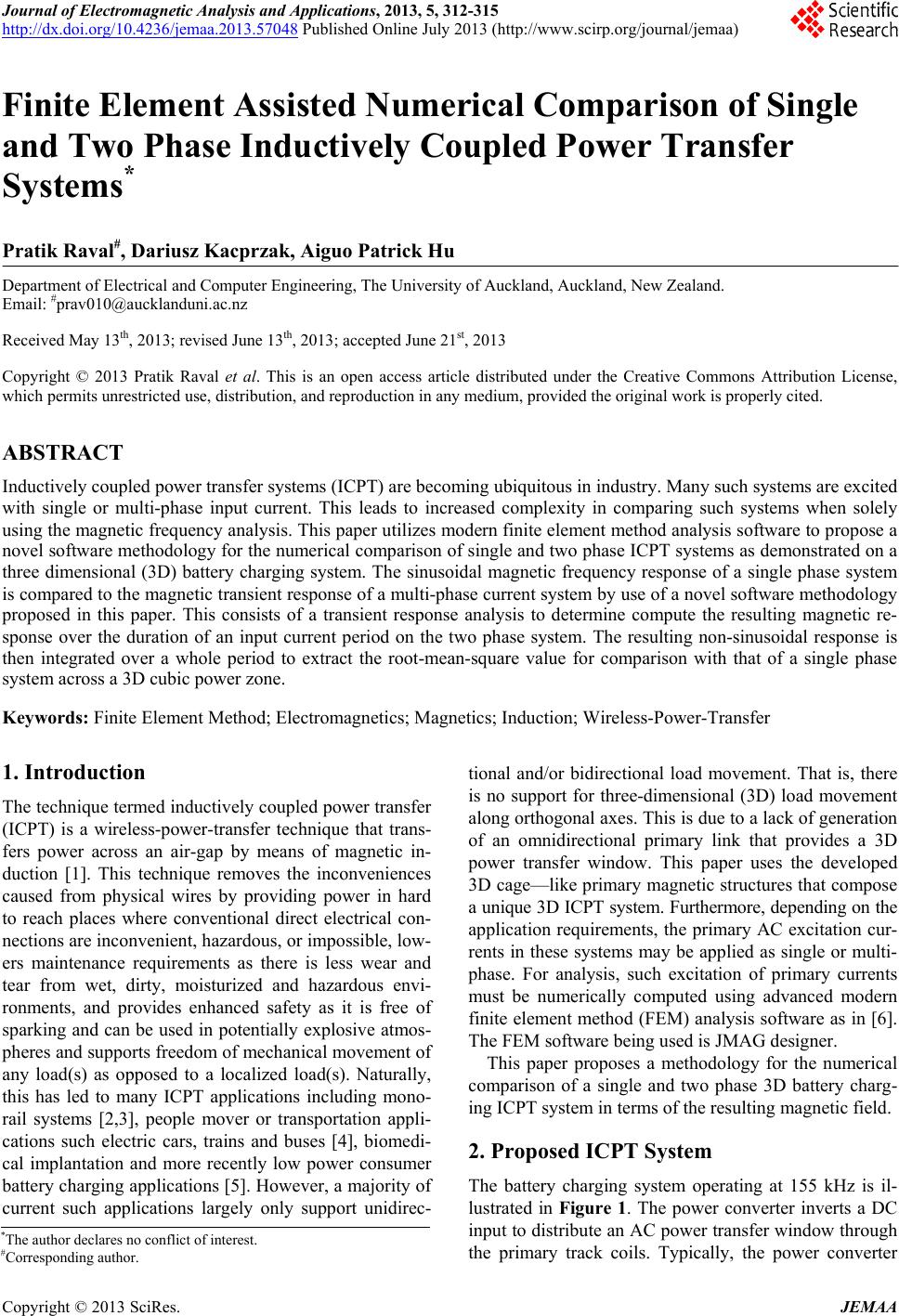
Journal of Electromagnetic Analysis and Applications, 2013, 5, 312-315
http://dx.doi.org/10.4236/jemaa.2013.57048 Published Online July 2013 (http://www.scirp.org/journal/jemaa)
Finite Element Assisted Numerical Comparison of Single
and Two Phase Inductively Coupled Power Transfer
Systems*
Pratik Raval#, Dariusz Kacprzak, Aiguo Patrick Hu
Department of Electrical and Computer Engineering, The University of Auckland, Auckland, New Zealand.
Email: #prav010@aucklanduni.ac.nz
Received May 13th, 2013; revised June 13th, 2013; accepted June 21st, 2013
Copyright © 2013 Pratik Raval et al. This is an open access article distributed under the Creative Commons Attribution License,
which permits unrestricted use, distribution, and reproduction in any medium, provided the original work is properly cited.
ABSTRACT
Inductively coupled power transfer systems (ICPT) are becoming ubiquitous in industry. Many such systems are excited
with single or multi-phase input current. This leads to increased complexity in comparing such systems when solely
using the magnetic frequency analysis. This paper utilizes modern finite element method analysis software to propose a
novel software methodology for the numerical comparison of single and two phase ICPT systems as demonstrated on a
three dimensional (3D) battery charging system. The sinusoidal magnetic frequency response of a single phase system
is compared to the magnetic transient response of a multi-phase cu rrent system by u se of a novel software methodology
proposed in this paper. This consists of a transient response analysis to determine compute the resulting magnetic re-
sponse over the duration of an input current period on the two phase system. The resulting non-sinusoidal response is
then integrated over a whole period to extract the root-mean-square value for comparison with that of a single phase
system across a 3D cubic power zone.
Keywords: Finite Element Method; Electromagnetics; Magnetics; Induction; Wireless-Power-Transfer
1. Introduction
The technique termed inductively coupled power transfer
(ICPT) is a wireless-power-transfer technique that trans-
fers power across an air-gap by means of magnetic in-
duction [1]. This technique removes the inconveniences
caused from physical wires by providing power in hard
to reach places where conventional direct electrical con-
nections are inconven ient, hazardou s, or impossible, low-
ers maintenance requirements as there is less wear and
tear from wet, dirty, moisturized and hazardous envi-
ronments, and provides enhanced safety as it is free of
sparking and can be used in potentially explosive atmos-
pheres and supports freedom of mechanical movement of
any load(s) as opposed to a localized load(s). Naturally,
this has led to many ICPT applications including mono-
rail systems [2,3], people mover or transportation appli-
cations such electric cars, trains and buses [4], biomedi-
cal implantation and more recently low power consumer
battery charging applications [5]. However, a majority of
current such applications largely only support unidirec-
tional and/or bidirectional load movement. That is, there
is no support for three-dimensional (3D) load movement
along orthogonal axes. This is due to a lack of generation
of an omnidirectional primary link that provides a 3D
power transfer window. This paper uses the developed
3D cage—like primary magnetic structures that compose
a unique 3D ICPT system. Furthermore, depending on the
application requirements, the primary AC excitation cur-
rents in these systems may be applied as single or multi-
phase. For analysis, such excitation of primary currents
must be numerically computed using advanced modern
finite element method (FEM) analysis software as in [6].
The FEM software being used is JMAG designer.
This paper proposes a methodology for the numerical
comparison of a single and two phase 3D battery charg-
ing ICPT system in terms of the resulting magnetic field.
2. Proposed ICPT System
The battery charging system operating at 155 kHz is il-
lustrated in Figure 1. The power converter inverts a DC
input to distribute an A C power transfer window through
the primary track coils. Typically, the power converter
*The author declares no conflict of interest.
#Corresponding author.
Copyright © 2013 SciRes. JEMAA